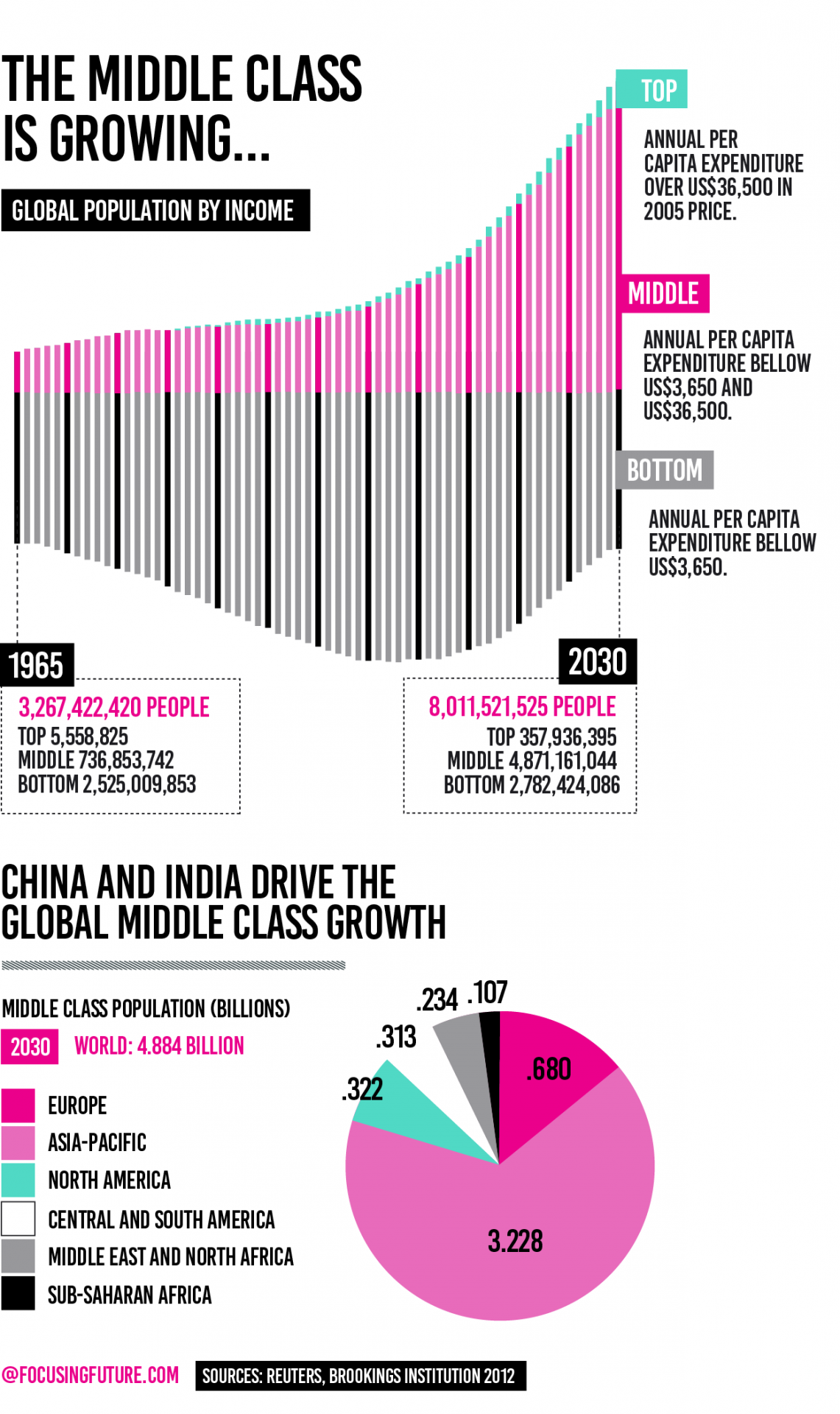![]() 5 minute read
5 minute read
Asia-Pacific population growth has a potential to bring the[nbsp]global economy to the level it was before the Global Financial Crisis. More people entering middle class with new money, demand, language spread, and new markets location. This article investigates the growth of middle class in next couple decades and its impact on the world’s business.
Birth of new
largest middle class
Global population grows by the impact of emerging economies like China and India. Emerging markets lift millions of households out of poverty. By 2030, the population of Earth is projected to be 8 million, with 29% of Indians and 20% of Chinese. Moreover, this will trigger the boost of countries economic growth. As the result of new education reforms and better life standard overall, the income distribution will change. Asia-Pacific region will host the upper end of income bracket, which is an impressive spending power.

Companies that today serve middle class in the US and Europe will switch to African and Asian markets. 4 billion people will have an annual per capita expenditure within the confines of $3,600 and $36,000. What is important is that middle-class growth is directly proportional to economic growth. Already today it is important to research and develop buying behavior of the south. As business integrates to the region, the emphasis should be done on the sustainable and eco-friendly habits. All the knowledge and experience of European development should be brought to Asia-Pacific region.
Chinese
cleantech
The growth of middle-class will reflect on the extensive urbanization. The sources of Cleantech demand is a growing middle class around the world and resource constraints. Therefore, investments in cleantech rise worldwide.
China is world’s second biggest economy with the strong industrial sector. Chinese carbon emissions are the largest in the world. Experts estimate that China’s emissions will peak around 2040 or later. Therefore, country concentrates on its cleantech sector, especially for manufacturing. As a matter of fact, China has overtaken EU in clean energy investments by spending 2.5x more on clean energy in 2015. It is expected that Cleantech industry will grow in China at an average annual rate of 15-20%. Establishing new cooperations with the reliable and cleantech-forward partners will solve Chinese cleantech challenges.
For instance, Beijing is actively working on generating new green solutions by collaboration with Finland. Finland is ranked second in the 2014 Global Cleantech Innovation and EU Eco-innovation scoreboard 2013. Beautiful Beijing is a cross-industry business platform for cleantech cooperation between Finland and China. In 2016, focus areas of the networking project are air quality, construction and design, energy, water solutions and industrial solutions.China and India are already today working on the more efficient and eco-friendly solutions for energy and heating provision. Investments in the region in energy and cleantech sectors will show impressive growth in the next decades. While solving existing carbon emission problems in China, the emphasis should be made for preventing the same path for India.
World Business Council for Sustainable Development launched the Energy Efficiency in Buildings laboratory in Shanghai. Research has shown that[nbsp]18.4 percent of emissions come from buildings. Laboratory has worked out[nbsp]Five-Year Plan for renovation and reimbursement of buildings towards sustainability. Following the example,[nbsp]Shenzhen, one of the world’s fastest growing megacities, released a draft of its five year action plan on building efficiency.
China and India are already today working on the more efficient and eco-friendly solutions for energy and heating provision. Investments in the region in energy and cleantech sectors will show impressive growth in the next decades.While solving existing carbon emission problems in China, the emphasis should be made for preventing the same path for India.
Hospitality
worldwide
According to World Tourism Organization, Chinese are leaders in global outbound travel with the highest tourism expenditure since 2014. More than 130 million Chinese tourists traveled abroad in 2015. The number is already significant even though only 5 percent of the Chinese population have a passport. As for today, Chinese tourists by more luxury goods than all other nationalities combined. The potential to expand the travel destination to the world’s largest population with growing income is tremendous.
Some countries already work on bringing more Chinese tourists to their vacation destinations. The world’s largest e-commerce company Alibaba established a connection with Rovaniemi resort in Finland. In 2017, Alibaba plans to bring Voice of China winners and concerts to the Santa Clause along with 50,000 Chinese tourists. “When something becomes popular in China, people go completely crazy. Every Chinese must see the auroras. If this comes to happen, there will be stellar amounts of travelers,” said Alibaba Group Marketing Director Chris Tung. Moreover, Alitrip has announced that it aims to fly six to eight million Chinese tourists to Europe in 2020.
Chinese example is describing the power of middle-class. The development will touch India, Africa, and other countries which will succeed to change income distribution enlarging the middle-class.




